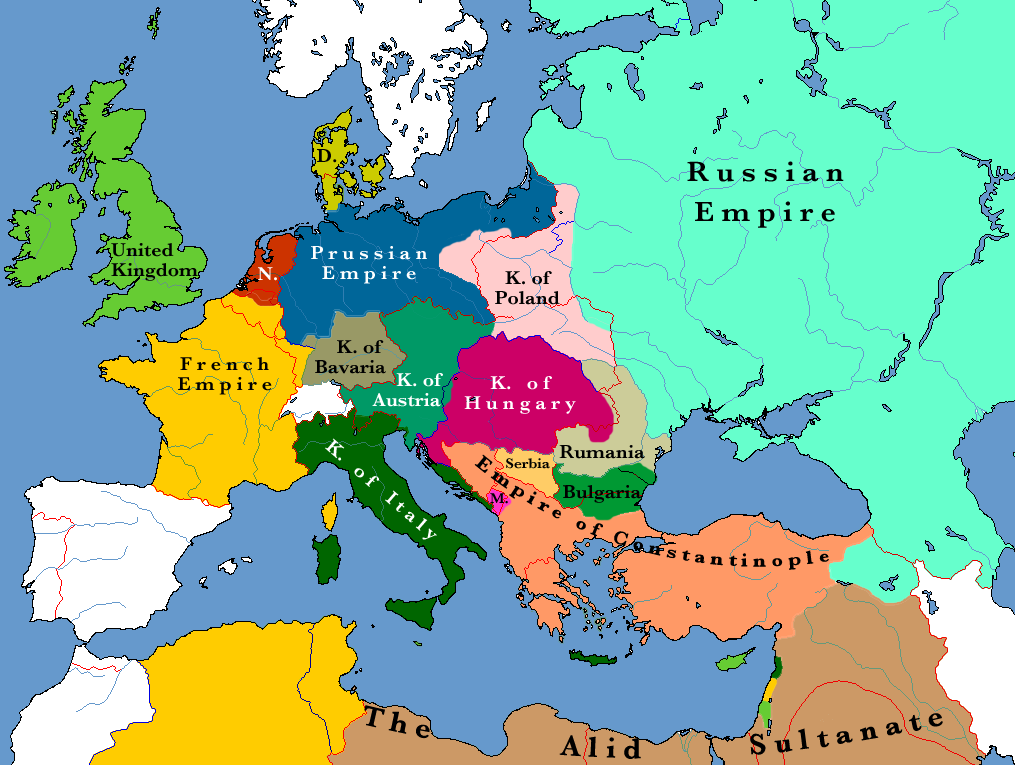Alternate History Europe in 1884
Last modified: 10th Dec. 2013
The point of departure of this alternative history is that the
negotiations which resulted in the Austro-Hungarian compromise of 1867
failed, and so the Dual Monarchy of Austro-Hungary did not eventuate,
but
rather Hungary remained simmering under the rule of Austria, which
became more militant and aggressive. The Franco-Prussian war of 1870-71
still took place, but Austria mobilized (although did not attack), and
the southern German states did not participate. As a consequence
France's defeated was less humiliating, and Prussia did not compel
southern Germany into its Empire until 1875. When Russia invaded the
Ottoman Sultanate in 1877, Austria also invaded, taking Bosnia and Novi
Pazar. Unbridled by Hungarian conservatism, the Austrian army then made
a dash to Salonika, to stop expansion by Bulgaria (a Russian client) in
Ottoman territory. This sparked a war with Russia, which in 1878
brought in most of the continental European powers:
1. Central powers: Austria, Germany, Greece and Rumania
2. Allied powers: Russia, Bulgaria, Ottoman Sultanate, France, and Italy.
The Ottoman Sultanate joined the Allied powers because it felt more
threatened by Austria than by Russia. France was seeking to regain
Alsace-Lorraine from Germany of course, and Italy was seeking territory
from Austria. Although the Central powers advanced on all fronts
(except Greece, which was quickly reconquered by the Ottomans with
French help), they were unable to achieve decisive victories. However
the Central powers scored major coups in encouraging the Poles (living
mostly in the Russian Empire) to rise in rebellion against the Czar,
and in persuading Ismail Pasha, the Khediv of Egypt, to declare
independence from, and then war on, the Ottomans. With Prussian
military advisers, Ismail regained the Ottoman territories his
grandfather (Muhammad Ali) had conquered in the 1830s, and created an
Empire stretching from Tunis to the frontier with Persia, plus Crete
and Cyprus. This alarmed the British, who saw it as a threat to their
own Imperial interests. Their entry into the war turned the tide
against the Central powers. Warn down by years of war and economic
blockade, they sued for peace in 1883.
The result of the 1884 Peace of Paris is illustrated, with countries
which were not involved left uncoloured. Amongst the allies, the
greatest winners were France and Italy. The Ottoman Sultanate had its
territories mostly restored in the west (and kept Greece, ending its 50
years of independence). But the once Khediv Ismail, now styling himself
Sultan Ismail of the Alid dynasty, only had his wings clipped:
France took Tunisia and Beirut, Italy took Crete and Tyre, Britain took
Cyprus and Jerusalem, and Russia took Armenia. This last compensated
Russia for the loss of its Polish territories. As the greatest loser
despite being on the Allied side, the Ottoman Empire fell into civil
disorder. Eventually the secularist Turks made common cause with the
Orthodox Christian leaders to create a modern constitutional monarchy.
The Sultan was forced to became merely Emperor, dropping all
pretensions to be leader of the Muslim world. The Empire was renamed
after its capital city and one third of the seats in the new diet
(whose procedings would be conducted in Turkish and Greek) were
reserved for Christians.
The map also shows the (mostly accurate) borders in actual
history in c.1884, resulting from
the 1878 Treaty of Berlin, which made peace in the Balkans
following the Russo-Turkish war of 1877-8, and the Austro-Hungarian
occupation of Bosnia and Novi Pazar in 1878. These were present on the
uncoloured map I began with. The colours I have chosen, by the way, are
based on those in the Atlas of
European History 2nd ed. (Times Books, London, 1998) so that I
would not think too hard about this.
Return to Howard Wiseman's History page

